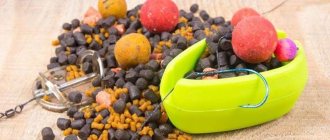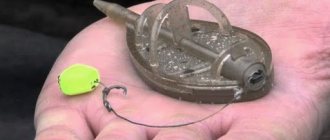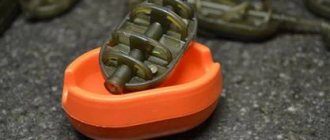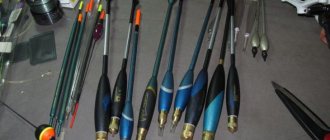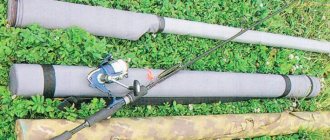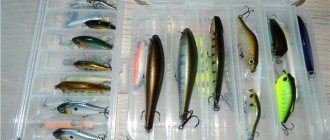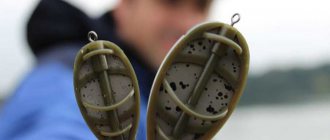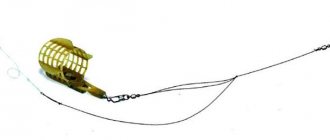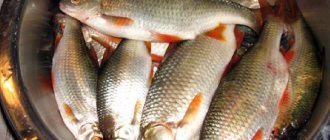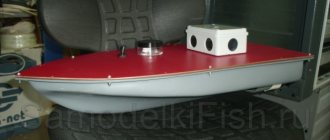The flat method (flet-fider-method) is a popular method of fishing in still waters and rivers with little current, it is part of method feeder fishing, and is often used when fishing for carp.
Such equipment allows you to catch not only small crucian carp, but also trophy specimens of carp. Below you can familiarize yourself with the peculiarities of the method and fishing tactics.
Feeder used in the flat method when fishing for carp on a feeder - allows you to make long casts, which is important in summer and early spring in the heat and heat
Flat method: what is it, what is the peculiarity of this feeder branch
A flat is a method feeder with a flat bottom. Attached to the structure is a hook with a leash, the length of which reaches 7-10 cm. If desired, the bait is hidden in the feeder along with the bait mixture.
Due to the structural features of the open feeder, the flat feeder works great in stagnant reservoirs. The flat base of the structure does not fall into the mud.
Flat method feeder
The main advantages of flat trading include:
- the ability to effectively fish areas of a reservoir with a silted/algae-covered bottom;
- correct location of the feeder in the water column;
- ensuring correct and accurate supply of bait mixture to a promising point;
- placing the hook with the bait on a clean area even after the bait is washed (the risk of snagging is reduced);
- self-hooking of fish;
- no risk of leash tangling.
The rapid washout of complementary foods in reservoirs with strong currents complicates the fishing process. This is considered the only drawback of the flat method.
Note! The type of feeder must be selected depending on the fishing conditions.
Homemade flat method feeders
The main advantages of flat method fishing
The most popular are flats from Preston, Drennan, ESP, Korum and they differ in:
- form;
- weight;
- sizes;
- coloring;
- frame configurations for holding bait;
- feed containers;
- type of connectors for tying a leash;
- loading form;
- cost.
The flat method is an economical type of fishing, but the price of imported feeders is still high, so it is welcome that our manufacturers have begun to compete with foreign brands and even win this competition.
The flat must have a streamlined shape in order to “break through the wind when casting, and a special mold device or “presser” is used to press the bait.
With the help of this gadget, it is possible to give a structure filled with bait excellent flight characteristics, and this allows you to fish at ultra-long distances. But other qualities of feeders are also important, on which their choice depends.
Flat weight
Feeders offered by manufacturers have a weight range from 10 to 120 grams, covering all possible fishing conditions.
When fishing at short distances, light weight flats, up to 30 grams, are used, and at a distance of 40 meters and further, heavier feeders from 40 to 120 grams are needed.
The choice of flat weight also depends on the test of the feeder rod used for fishing and this should also be taken into account. When testing a rod weighing 90 grams, feeders weighing up to 90 grams are used along with bait.
Unfortunately, situations are possible when, during a power cast, a rod breaks, the test of which is lower than the weight of the flat with bait. But this happens if the load on the form is maximum.
The main difference between feeder gear and carp gear is the presence of some free play of the fishing line relative to the sinker lying on the bottom. In any feeder installation, the fish has the opportunity to take the bait and make a movement without lifting the load.
As a result, the tip of the feeder moves, and the angler makes a hook. This kind of fishing allows you to catch not only large fish that can pull a load from the bottom, but also smaller ones.
You can also use this method of fishing in the current with a heavy sinker. A lot has been said about the equipment on forums and in videos on YouTube.
The most detailed information could be gleaned from seminars with Sergei Popov.
The main goal of fishing on a flat feeder is crucian carp. Its habits are very similar to carp, but it is picky about baits and often takes on animals and even fry.
Classic carp gear is a bit rough for him, but feeder gear with a flat feeder is very suitable. You can use both regular feeders and other variations on this theme - banjos, pacifiers.
The main thing is that the tackle with such a feeder must have free movement of the hook relative to the sinker.
The simplest installation, similar in appearance to carp, is inline on the leadcore. Leadcore makes the fall of the feeder more horizontal, since it has some weight, and it does not stick into the bottom with an edge.
The hook can be stuck into the feeder or left free, as with conventional feeder fishing. The free hook additionally allows you to diversify your fishing using a long leash.
The bait is located in the water column, attracting active fish from great distances. This helps when catching roach, which often looks for food not at the bottom, but in the water column.
Usually, only a hook with a boilie is stuck into the feeder; placing a hook with a regular attachment inside is not so effective.
On currents, a flat feeder is rarely used and only on weak currents. Mainly due to the fact that the flat feeder itself holds the food very weakly, and it will be instantly washed out of it.
This forces the use of more viscous baits, which behave differently in the water column than usual. Due to the peculiarity of the feeder, the feeding spot will be strongly extended along the current, since already during the fall the feed will begin to be washed out and it will be carried down.
The author does not practice this method of fishing in the current, but those who use it prefer a paternoster for the current with a flat feeder. Apparently, this is how it should be caught.
And here's what you need to know: Fishing for tench using various tackles
What is needed for flatt
For flat fishing, fishermen use feeder rods. The length and test of the gear are selected depending on the fishing characteristics. When choosing a fishing rod, you should pay attention to the casting distance.
To fish the coastal zone, it is worth purchasing medium feeders/pickers, the length of which reaches 3.6 meters (test up to 60 g). When casting over distances of up to 60 meters, 3.9 meter blanks with dough up to 90 gr are suitable. For long-distance casting, it is advisable to buy an extra heavy feeder with a length of 3.9 - 5 meters (test more than 80 g).
If you plan to catch large fish, you should give preference to slow action feeders. In other cases, you can use medium/fast action rods.
Among the best feeders that are suitable for flat fishing are:
- Stout Feeder – the length of the gear suitable for fishing small crucian carp/bream is 2.7 m;
- Angler Heavy Feeder , designed for fishing large fish;
- Jester Feeder – universal feeder;
- Avenger is a rod for sport fishing.
After the tackle has been selected, it is worth thinking about the question - what type of feeder to choose. The designs of the flat version feeders are similar. They typically consist of a flat, heavy base and a framed plastic/solid metal top designed to be filled with bait. The type of feeder is selected depending on the fishing conditions:
- to make long casts, it is worth using feeders whose weight is equal to 2/3 of the upper test of the tackle;
- when fishing a reservoir with a silted bottom, it is necessary to give preference to flat structures whose center of gravity is not displaced;
- For fishing in the coastal zone, light weight feeders will be required.
Advice! Before you start choosing a feeder, you should decide in advance on the type of attachment. The distance between the ribs of the structure differs, so it is important to choose a model that can accommodate a specific nozzle.
When fishing areas of a reservoir with a small current, and casting over long distances, it is better to use not a fishing line, but a braided line, the diameter of which is 0.12-0.14 mm. At the same time, a shock leader is added to the equipment.
To catch trophy fish, you should use a monofilament with a diameter of 0.22 - 0.30 mm.
Among the best models of monofilament fishing line for flat equipment, it is worth highlighting:
- Colmic method feeder;
- Browning Feeda Line Cenex;
- Sensas Feeder Tech Competition.
The best braid models suitable for flat fishing: Daiwa Tournament, Powersink Braid X4 PE, Sunline Siglon PE X4, Daiwa J-Braid X4.
The coil for a flat feeder must be powerful enough. Depending on the thickness of the cord and the characteristics of the tackle, the size of the spool is selected.
When going fishing for crucian carp, you can install a reel of size 2500. If you plan to catch more serious prey, you should give preference to reels marked 4000. The highest quality models are considered:
- Feeder Concept Pilot;
- Daiwa Regal 4000 XIA;
- Kaida Dragon FA 3000;
- Preston PC-R 6000;
- Banax Helicon 500NF;
- Teben AQR-400;
- Kaida MJ 5000A;
- Flagman Force Active Feeder.
To absorb strong jerks of the fish and prevent the risk of the leader breaking, it is worth using a feeder. It must be installed between the main equipment and the leash. Experienced fishermen recommend choosing Feeder gum or Power gum rubber thread. The length of the feeder is selected depending on the type of equipment.
For flat installation, small hooks of sizes No. 2, 4, 6 are used. Korda Mixa, Korda Krank, Gardner Mugga are best suited.
Hook numbering
Gear assembly
Since flat fishing involves catching trophy specimens, you should take all elements of your gear seriously. A properly selected rod, reel and line will ensure reliable landing of fish and will allow you to easily cast feeders of any weight.
Rod selection
For fishing on a flat feeder, it is not recommended to choose rods with a fast and especially super-fast action. Rigid fishing rods are well suited for high-speed fishing for small fish, when you need to cast the equipment as accurately as possible and quickly pull out the trophy that is hooked.
A feeder rod for catching large specimens must have:
- short in length, which will allow you to fish in cramped conditions when the shore of the reservoir is overgrown with trees or bushes;
- medium or slow action, which makes it possible to effectively dampen the jerks of large fish and allows the use of thinner leader materials in the equipment;
- a large margin of safety, which will be useful during forced fishing.
For comfortable fishing, the angler will need comfortable rod stands.
Since most of the fishing day the tackle is on stands, it makes no sense to purchase the most expensive and lightest rods made of high-modulus graphite for the flat feeder method. By increasing the lightness of a fishing rod, manufacturers inevitably reduce its strength characteristics and reduce the rod’s resistance to abrasive loads. It would be good if the upper part of the rod handle was made of EVA material, which is much easier to clean off dried bait than cork.
For fishing on small ponds, a rod 2.7 m long with a test weight of up to 40–50 g is quite suitable. If you plan to fish on a large pond or lake, then it is better to arm yourself with more powerful gear, which includes a fishing rod 3–3.40 m long with a weight of up to 80 grams, which will allow you to throw a heavy feeder to a promising hole or snag.
Optimal coil
The rod will need to be equipped with a commensurate reel from a trusted manufacturer. For flat fishing, spinning reels of the 2500–3500 series are used. Many fishermen make the mistake of installing models with a large additional number of bearings, intended for match fishing, on method gear. Due to the large number of bearings, such reels have poor power traction, which is unacceptable when fishing for trophy fish.
In addition, when it comes to catching large specimens, for which you have to wait several tens of minutes for a bite, the speed of reeling out the fishing line is completely unimportant. Reliability and power characteristics, which distinguish reels with a small additional number of bearings, come to the fore.
A reel with a baitrunner is the best option for carp fishing.
Particular attention should be paid to the operation of the friction brake. The friction must be finely tuned and ensure a smooth release of the monofilament from the spool during strong tugs of the fish. Proper operation of the friction brake will allow the angler to fish out weighty specimens on a thin line.
For carp fishing, it is better to use models with a baitrunner system. The carp bite is very sharp and, if the clutch is tightened tightly, the tackle may end up in the water. The baitrunner system ensures free movement of the monofilament from the spool and prevents possible loss of gear.
Selection of monofilament
When assembling gear, the angler needs to decide what type of monofilament he will fish with. The flat method allows the use of both braided cords and monofilament line. Braided lines have a higher breaking strength than monofilament line.
When fishing using the flat method, it is better to use monofilament designed for fishing on a feeder.
In addition, the braided line has almost zero elongation, which is important when fishing for fish such as crucian carp and bream, whose bites can be very careful. The disadvantages of braided wire include:
- lack of shock-absorbing properties, which does not allow the use of small hooks and thin leashes;
- low resistance to abrasive loads, leading to frequent breakages of equipment;
- high price, which can be an order of magnitude higher than for monofilament monofilament;
- short service life, limited to 1–2 seasons.
How to tie a feeder feeder
In feeder fishing, braided cords with a diameter of 0.08–0.16 mm with a breaking load of 2 to 10 kg are used. Preference should be given to four-core cords, which are less susceptible to damage from stones and sharp edges of shells.
For carp fishing, only monofilament fishing line is used, which is associated with the energetic bite and active resistance of this fish. Monofilament filament has a number of advantages:
- good shock-absorbing qualities, helping when landing fish and allowing the use of thinner equipment;
- good resistance to abrasive loads, which ensures the reliability of the gear;
- low price, which allows you to replace the fishing line without significant material costs on the part of the fisherman.
For flat fishing, monofilament fishing lines with a thickness of 0.20 to 0.30 mm are used. If a braided line is used for carp fishing, then in this case it becomes mandatory to have a reel with a baitrunner system.
Installation of equipment
Installation of flat equipment can be either sliding or stationary. In the sliding version, the feeder moves freely along the leadcore (a cord with a lead core inside), which significantly increases the sensitivity of the gear. In the stationary version, the feeder is rigidly fixed to the leadcore. Sergey Popov, who is actively promoting the flat method in Russia and is a repeated winner of competitions in this type of fishing, recommends a stationary option. His fishing practice has shown that installation with a fixed feeder almost completely eliminates idle bites. One of Sergei Popov’s rigs, intended for carp fishing, is knitted as follows:
- At one end of a piece of leadcore 60–80 long, a swivel is tied.
- At the other end, a feeder is put on the leadcore and moved close to the swivel.
- While holding the feeder, the fisherman forcefully pulls the free end of the cord, thereby driving the swivel halfway into the body of the bait structure.
- A plastic cone is placed on the cord to secure the feeder at the top.
- The free end of the leadcore is tied to the main monofilament thread with a counter knot.
- A leash 5–12 cm long is attached to the swivel.
When installing flat feeder equipment, high-quality medium-sized swivels are used.
The use of sinking leadcore with a metal core is quite justified. The sinking line immediately falls to the bottom and makes the equipment invisible to the fish. The material used for the leash is leash material with a breaking load of 8–10 kg. If you plan to catch carp with boilies or large pellets, then attach the bait to the hook using a hair rig.
The sliding version has increased sensitivity and is more often used when fishing for crucian carp and bream. The knitting pattern for such equipment is as follows:
- A swivel is attached to the end of a monofilament line with a diameter of 0.35 mm.
- A buffer bead is placed on the fishing line.
- The feeder is attached to the monofilament.
- The free end of the fishing line is tied to the main monofilament with a counter knot.
- A short leash made of “braid” or leash material is attached to the swivel.
The monofilament on which the installation is knitted must have negative buoyancy and a dark color, less noticeable on the bottom soil. With this design of the flat method equipment, the most careful bites are transmitted to the tip of the rod.
Flat mounting options
Below you can find step-by-step instructions for the most popular types of installation.
Blind installation of a flat method feeder on a feeder
To perform this type of installation, you will need to select a swivel to match the diameter of the feeder tube. The swivel should fit tightly into the structure. Additional use of the connector will ensure a strong connection. The connector is pulled from above onto the swivel and threaded into the feeder tube.
Blind equipment and fishing using the flat feeder method:
Step-by-step process of blind installation
- First of all, anglers make a loop at one end of the leadcore, the length of which is 60-80 cm. The loop is formed from a piece 16-20 cm long.
- The opposite tip of the leadcore is passed through the body of the feeder.
- A connector is threaded through the leadcore and a loop with a swivel is knitted at its end.
- The connector is placed on a swivel.
- The feeder is brought to the swivel and pulled by the opposite edge of the leadcore. The connector with the swivel should fit tightly into the feeder throughput tube.
- A leash is mounted to the swivel, the length of which reaches 10 cm.
Sliding installation of flat feeder
If the fish is passive, you should use a sliding installation of a flat feeder. To do this, make a loop on one side of the fishing line through which the equipment will be connected to the main fishing line/cord. A feeder is passed through the fishing line and a bead is threaded through, which protects the knot from the feeder and prevents it from getting onto the swivel. Having tied the swivel, you should attach a leash, the length of which reaches 35 cm.
An example of flat method feeder equipment on a method feeder
Flat feeders
The designs of flat method feeders are similar. Typically this is a flat, heavy base and a framed plastic or solid metal top to accommodate bait and bait. A tube or channel passes through the body to pass the fishing line. The configuration of the stern part, weight, and dimensions determine for what fishing conditions the feeder is most suitable. An amateur does not need dozens of models. The average fisherman uses several. And in order to choose the right one and fish comfortably, you need to understand the varieties offered by the market today.
Design
The feeder method uses various feeders:
- Actually, flat.
- Classic petal method.
- Banjo.
- Scoops for pellets – sticks.
Entry and exit to the leash
Let's consider the average flat feeder for the feeder, without reference to a specific manufacturer for now. The basis of the structure is a heavy flat bottom, either separate from lead or as part of an all-metal structure. The larger the heel area, the higher the feed capacity. Accordingly, a large feeder takes a lot of food and flies worse, but it lies better on soft silt without falling into it. The heel shape is oval or teardrop-shaped. The teardrop shape has better aerodynamics and flight capabilities, since the wide part at the bottom is heavier, and when casting it flies in front. However, the larger and wider the base, the less stable the flight, the cormak begins to scour to the sides, accuracy and range decrease. Some manufacturers intentionally make the front end heavier to improve performance.
The body is attached to the heel with rivets or screws. Only some models have a solid cast body and heel. The plastic body consists of several ribs to hold bait. Previously, feed was stuffed by hand, but now manufacturers supply their products with special pressing molds (trampling machines). These molds (from the English name mold) are specific for some models, but for others they are also suitable for other manufacturers. Naturally, the angler’s mold size must be suitable for the existing feed. It is better to use original compactors.
Equipment Features
The upper part of the channel for passing the fishing line is equipped with a boot so that the fishing line or leadcore included in the design does not get tangled, the lower part is equipped with a knot for tying the leash. Usually this is a special groove into which a swivel or quick release (quick-link, pear) for a leash is inserted. In this factory version, the equipment turns out to be blind, but you can also make it sliding by adding a bead in front of the swivel. The leash is short, 8-15 cm. You can always make it 10 cm and not worry. Leashes can be knitted from fishing line, braid or leash material. The hook size is selected depending on the nozzle. You can use either a hair rig for boilies or pellets, or simply attach it directly to the hook. More details - equipment options for flat feeders.
Blind equipment
Blind equipment is used more often. In this case, the fish itself is spotted. This is especially necessary when fishing at a considerable distance, where there is no point in inline sliding - the fish touching the nozzle is still not visible due to the sagging line. A sliding rig is needed for catching cautious fish in the near zone, no further than 40 meters. In this case, self-cutting does not occur, and the fisherman needs to constantly monitor the gear.
Inline equipment
Flat with elastic
The flat was originally designed for carp fishing. But, having migrated to the feeder, the method is now used to catch a variety of fish in still water. Sometimes, as in a classic feeder, the use of ultra-thin leashes is required. However, especially in the case of a blind rig and a braided cord, there is no shock absorption of the rig, and therefore it is easy to lose a trophy on a thin leash. In the feeder, this problem is solved by a spacer made of elastic material. Some manufacturers offer flat elastic feeders with a feedergam insert in the channel. This length absorbs jerks of the fish and prevents the leash from breaking. The soft elastic material wears out quickly, especially after landing large fish. Therefore, it must be replaced periodically with a new one.
Method
Method feeders are the founders of flat feeding, and are now used less frequently. However, petal methods can be used in the current, making the bait more sticky. The principle is the same as that of a conventional bottom spring. The feeding capacity of this method is much greater than that of flat feeders. Therefore, method baits are more suitable for targeted hunting for carp or carp, when large portions of bait with large particles (for example, corn) need to be delivered to the point. Read more about method feeders.
Banjo
Feeder banjos are flat in miniature. Essentially, this is a plug with sides for loading feed, loaded at the bottom with a flat sinker, with a through channel through the structure for inline fastening, as in flat. Banjos with low food capacity are used for passive, wary fish when it is not possible to sprinkle a lot of food, for example, in spring or autumn. Also, these mini-feeders can be used for targeted catching of small fish using the flat picker method.
For example, Preston Banjo Elasticated with feedergam is used for accurately catching small fish near the shore with thin leashes. The bait in the banjo is made more sticky so that the mixture does not wash out quickly. Frequent recasts to catch cautious and timid fish should not be done.
Scoop
Occasionally, fishermen can see sticks of a semi-closed type – scoops – on a pond. Initially, they were developed for pellets for normal delivery without washing out to great depths. However, properly prepared bait does not wash out from ordinary flat bait. Athletes love scoops - they are good for high-speed fishing. He quickly stuffed the food inside with his finger and rethrew it. Saves time on stuffing feed with mold.
How to fish flat, suitable bait and bait options
For flat fishing, you can use animal/vegetable baits. Experienced fishermen claim that a good bite is observed when baiting a hook:
- boilies;
- corn;
- peas;
- worm;
- maggots;
- bloodworm.
The use of the flat method involves separate mixing of bait intended for the feeder and for feeding a promising area of the reservoir.
Using a bait mixture for feeding allows you to attract the attention of the fish and keep it in the fishing spot. The fraction of feeding mixture ingredients must be large. Fishermen recommend adding boilies, corn and pellets to the feed.
The bait should be sticky. It is important that during casting it does not fly off the feeder, withstanding a forceful swing, hitting the surface of the water and, in the process, sinking to the bottom.
Starting feeding can be done manually or using a slingshot. The bait mixture can be purchased at fishing stores or prepared independently. The best brands of fish food today are Dunaev, Sensas, FFem.
Feeder bait in a method type feeder
Flat feeder method
The flat-method open feeder was invented after many years of observing underwater inhabitants, in particular after a detailed study of their feeding habits. Today, even a novice fisherman knows that domesticated and wild carp (carp), bream and some of their close relatives consume food by suction. If you lower the underwater camera from the boat and watch the actions of the same bream, you can see how it sucks in everything with its “telescopic” mouth, like a vacuum cleaner, filters and spits out inedible particles. The same thing happens with a flat-method feeder: the fish sucks the food washed out around it until there is a hook in its mouth.
In the classic version, the method type feeder consists of a frame (grid) and a lead weighting agent. Weight varies from 30 to 80 g, which is quite enough for fishing in rivers with moderate currents. Usually, casting a feeder with such a mass does not require a powerful rod, but this is not the case. All elements of the tackle, including the reel and fishing line, must have a certain margin of safety, since this method is used to catch mainly large and strong fish.
The vast majority of feeders of this type are made of plastic, although recently lightweight metal products have also begun to be common. Their upper part is open; there are several characteristic protrusions on it for binding bait.
There are three types of method feeders: for fishing on silted reservoirs, for fishing on a hard bottom, and also for fishing in weak currents or in stagnant ponds and lakes. Models from the first category are distinguished by a shifted center of gravity, due to which they always fall to the bottom surface in the same position. The loaded side is on the bottom, and the groundbait and hook with bait are on top. It's like a tumbler doll. The fisherman need not be afraid of the “burial” of the hook; it always remains on top. At the same time, the flat bottom holds the feeder even on very soft ground and does not allow it to sink into a thick layer of silt.
Fishing tactics
Flat fishing allows anglers to use multiple gears. One of the feeders can be thrown to a previously baited area of the reservoir, and the second tackle can be used to search for another point. You can try to fish shallow areas located near the reeds and cast over long distances. If there is not a single bite for 10-15 minutes, you should change the point.
To find a promising point, you should stick to the fan method. Each subsequent cast is performed to the left/right of the previous one. You can also change the casting distance.
After waiting for the first bite, you should throw the bait in the same place. The hook when fishing on a flat feeder should be short but sweeping. If the next bite follows, you can safely begin fishing this zone. A promising point has been found.
Advice! Casting must be done at intervals of 15 minutes.
Method reel and bait reel
What are the advantages of flat fishing?
If the bottom of the reservoir is very viscous, there is a lot of snags, grass, and you just don’t want to catch small fish, in such situations a flat is irreplaceable. This is achieved due to the flat bottom of the feeder, which almost does not get stuck. If the bait is fed directly into the feeder, there should be no problems with snagging on algae and snags. Significantly fewer gatherings. The fish may not take the bait, but it will definitely want to dig into the bait on the feeder, which will lead to the hook being sucked in.
Flat fishing is not active and it is not at all necessary to sit constantly looking at the top of the feeder; you just need to loosen the clutch of the feeder reel, or turn on the baitrunner, if you have one. When there is a bite, a self-hook must occur, then you need to hook the fish and fish it out.
One more point that concerns flat fishing in silty reservoirs: after casting the feeder, do not pull on the tip of the feeder; it will be enough to simply remove the slack on the fishing line or cord, but no more. This is due to the fact that when pulling up it is possible to drive the feeder into the silt. There are also slight differences in feeding fish.
The flat shape of the bottom of flat feeders does not allow them to go very deep into the silt.
If with ordinary feeder fishing you need to constantly supplement the feed, then here it is a little different. Groundbait for feeding and complementary food for the feeder must be mixed separately.
Feeder bait for feeding is needed to attract and retain fish, and, as in carp fishing, eighty percent of the bait is sent to the point immediately. The feeding mixture should contain a lot of coarse fraction (large fish are usually caught with flat fish), so the bait should contain the following components: pellets, boilies, corn.
For more information about feeder fishing, see the section at the link.
How to catch crucian carp on flat
To catch crucian carp using the flat method, you should use animal baits (worms, maggots, bloodworms), as well as corn, peas and pearl barley. It is worth adding flavorings to the bait. In the warm season, sweet additives are perfect, and in early spring and autumn it is better to give preference to garlic flavor.
In summer, it is worth fishing areas of the reservoir near reeds, holes and depth changes. At the end of autumn, you need to look for silver in the depths and under the edges. It is best to use 2 tackles. With the second rod, you can fish the pond in search of promising places, re-casting the tackle in different directions every 10 minutes until the first bite.
How to catch carp using the flat method
A correctly selected bait provokes fish to bite. When fishing for carp, you should hook:
- floating boilies;
- pellets;
- worm;
- corn;
- sinking boilies;
- foam balls.
In the warm season, pop-up baits work most effectively.
It is better to use Dynamite baits Browning, Sensas and Marcel VDE for carp fishing.
When a promising fishing point has been found, it is worth starting feeding with 4 feeding troughs. The first pair of feeders should be free of food at the bottom, and the second pair in the water column. In this way, it will be possible to create a feeding spot in which the feeders will be hidden.
How to catch bream
To attract the attention of bream, it is worth adding a small amount of flavoring (chocolate, strawberry, hemp) to the bait. It is better to use blind equipment, thanks to which the fish catches itself. Having cast to a promising point, all you have to do is wait for a bite. The frequency of re-casting the tackle is every 20 minutes. If there is not a single bite for 40-60 minutes, it is worth changing the area of the reservoir being fished.
Classic flat method feeder - video from an expert, fishing tips:
Tips and secrets
Avid fishermen are happy to share the secrets of fishing using the flat method with beginners.
- The consistency of bait for the flat method should not be like plasticine.
- If you plan to catch large fish, you should purchase a reel with a baitrunner.
- It is recommended to use boilies with a diameter of 10-12 mm as bait.
- The hook should only be performed at the moment of a strong blow, which will bend the rod blank.
Flat fishing is becoming increasingly popular among anglers who don’t like to spend hours feeding a certain area of the reservoir and waiting all day for a bite.
The flat method allows you to quickly find a promising place and start fishing it. In order for a trip to a reservoir to bring the desired result, and for the fish tank to quickly fill with fish, it is worth properly equipping the feeder and listening to the advice of experienced fishermen regarding flat fishing tactics.
Equipment with bait and bait
At first, flat method feeders were loaded by hand. Nowadays it is customary to do this using a special tool - a mold. The mold is supplied complete with feeders or separately, depending on the manufacturer. Types of flat feed compactors:
- Silicone;
- Made of hard plastic;
- With a button.
The simplest and most reliable molds are silicone. They are practically indestructible and will last for many years if not lost. A common practice for flat fishing is to press the bait with the hook directly into the feed. To do this, the hook with the nozzle is placed in the mold. If you need to deepen it into the bait, then first pour a little mixture into the mold, and only then place the nozzle in it. Next, add a little bit of bait into the mold. We put the feeder in it and press it. After removal, a neat lump of food is attached to the feeder, and the nozzle is hidden in it.
Proper bait is the basis of the flat method. The composition is important here. The mass should be molded and held on the feeder during casting, but at the bottom in the water it should collapse and release the bait. Read more about the correct flat bait.
Which nozzle can be used:
- Boilies 10-12 mm (larger ones are possible for large carp), sinking and floating;
- Pellets;
- Snowmen and mushrooms (sandwiches made of pelets and halves of a floating Pop Up boilie on top);
- Corn;
- Worms;
- Peas;
- Styrofoam balls;
- Maggot.
Any attachment will do. You need to experiment with bait. At one time the fish reacts better to a lying bait, at another time to a floating one. A good practice is to ensure that the bait is neutrally buoyant so that it only rises slightly from the pile of food, but does not float. You can also lift animal baits with a piece of foam on a hook. This presentation enters the fish’s mouth easily, with the slightest suction. Feeder hair equipment is usually used on hooks. But you can attach bait directly to the hook, as well as through Maggot clips.
